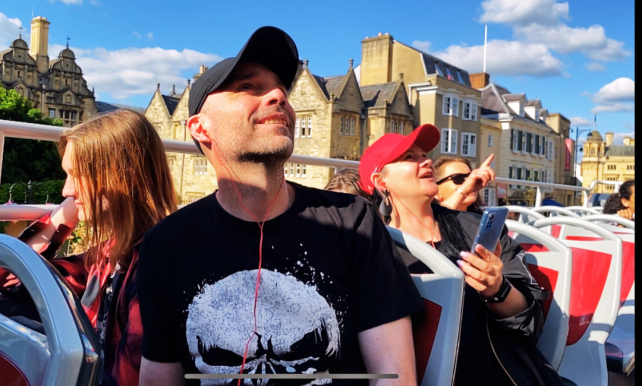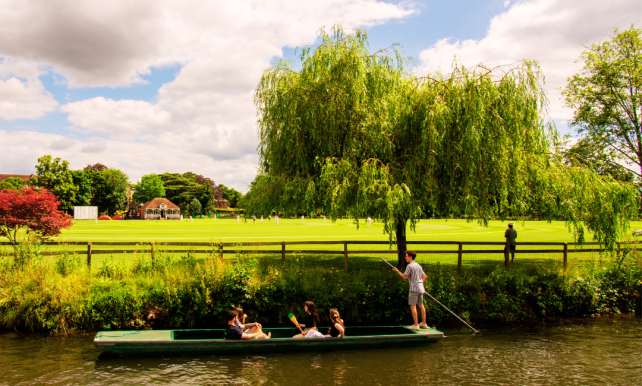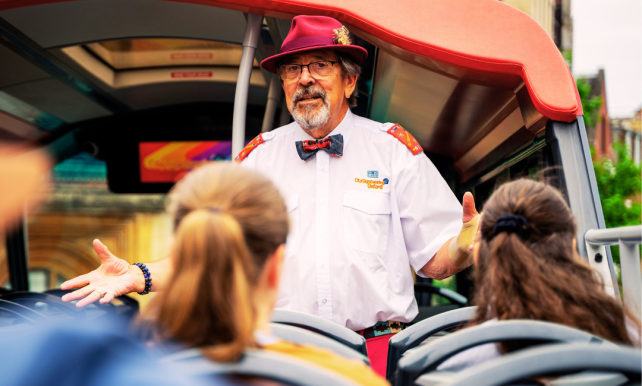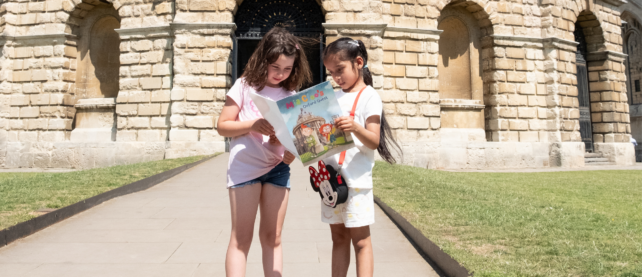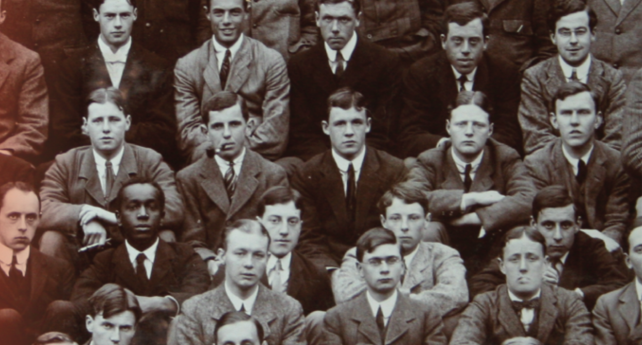Bike and Bus Tour – Oxford Highlights

Bike and Bus Tour – The Oxford Highlights
Summary
Discover the four most picturesque streets in Oxford.
Recommended duration: 1 to 1:30 hours (depending on stoppage times, easily ridable within 15 minutes)
Distance: 1 mile
Map overview
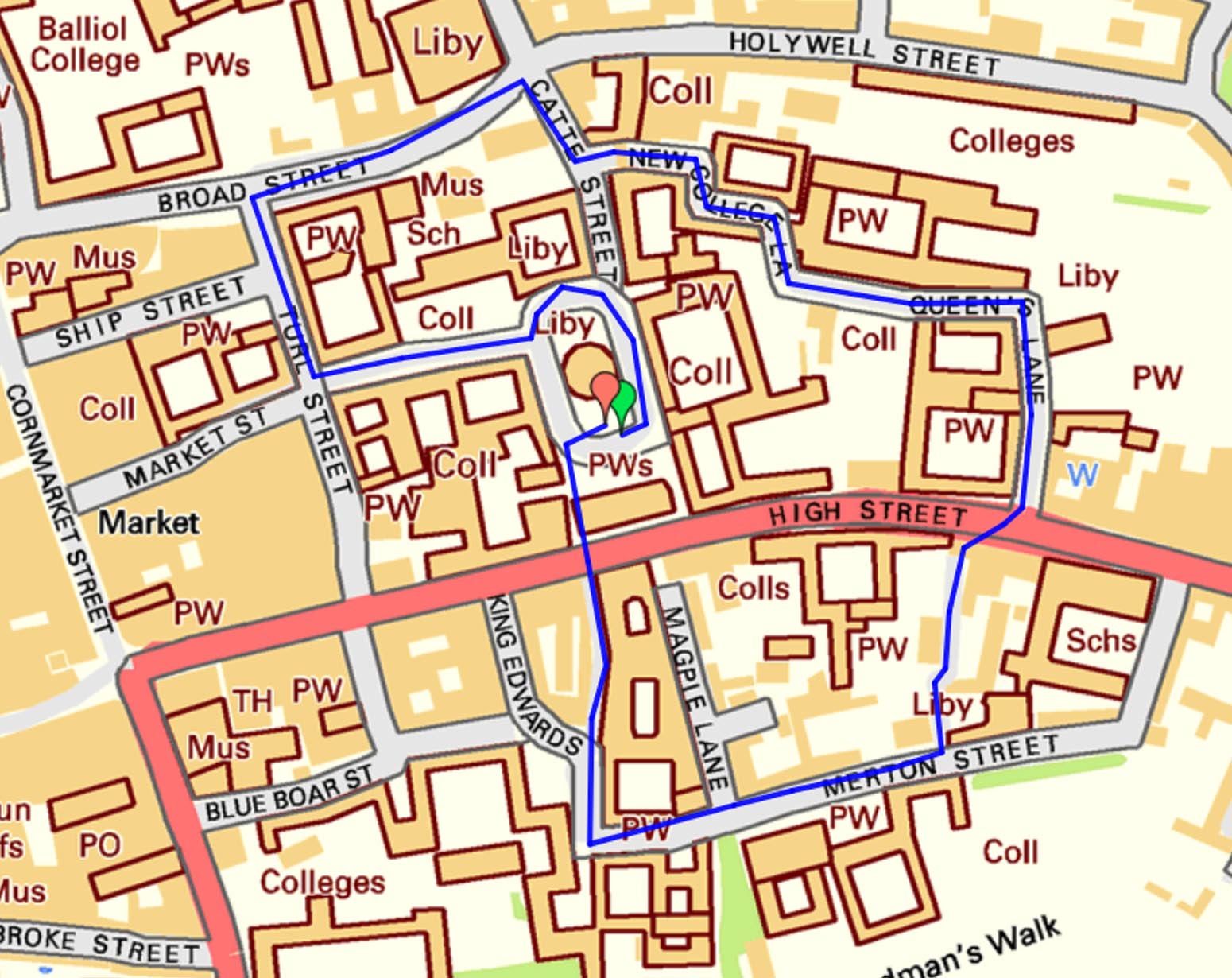
Directions and points of interest summary
- Depart the City Sightseeing Oxford bus at stop 8 – Radcliffe Camera.
- Walk the short distance to Radcliffe Camera heading up St. Mary’s passage or Catte Street to collect your hire bikes.
Point of interest: Radcliffe Camera
Point of interest: St. Mary the Virgin Church - Follow the road to the right of the Radcliffe Camera around Radcliffe Square keeping the Camera on your left-hand side.
Point of interest: All Souls College - Follow the road around to the left, keeping the camera on your left.
Point of interest: The Bodleian Library - Leave Radcliffe Square by turning right onto Brasenose Lane.
- Turn right onto Turl Street.
- Turn right onto Broad Street.
Point of interest: Broad Street – Oxford Martyrs memorial cross
Point of interest: Balliol College
Point of interest: Weston Library
Point of interest: Sheldonian Theatre - Turn right onto Catte Street.
- Turn left onto New College Lane and ride under the Bridge of Sighs.
Point of interest: The Bridge of Sighs
Point of interest: The Turf Tavern – can be accessed through the small passageway just after the bridge on the left
Point of interest: New College Lane - Follow new College Lane as it turns into Queen’s Lane. It’s good practice to ring your bell as you navigate the corners, and you will hear local cyclists doing the same to warn of them coming.
- When you reach High Street, cross the busy road and turn right.
- Turn left onto Logic Lane (off-road path).
Point of interest: Logic Lane - Turn right onto Merton Street.
- Continue straight ahead on Merton Street past Magpie Lane (on your right).
Point of interest: Merton College - Follow the road to the right at the back entrance to Christ Church onto Oriel Square.
Point of interest: Christ Church
Point of interest: Oriel College - When the road forks, take the road (with a barrier in front) on the right up Oriel Street.
- Cross High Street and go straight up St. Mary’s Passage.
- End of tour back at Radcliffe Camera.
Points of interest (explained)
Radcliffe Square
We are now in Radcliffe Square which takes its name from John Radcliffe a student of the university who, became a doctor to King William and Queen Mary, made a large fortune, and left a significant legacy to the University and his college (University College). We are surrounded by Oxford University buildings. The impressive building in the centre is the Radcliffe Camera. It was originally called the Radcliffe Library of sciences until it was taken over by the Bodleian because of underuse and renamed the Radcliffe Camera (the word camera means a room or enclosed space in Latin) which now houses English, History and Theology.
To the East is All Souls College, which has only fellows, no students (fellows are appointed by the college to a position which normally grants financial aid for providing further study and research) making All Souls dedicated to research. It has a reputation for academic elitism. Some of the youngest fellows take an entrance exam which used to also involve writing an essay based on a single word.
To the South is the Church of Saint Mary the Virgin where the Oxford Martyrs were tried. This Square has been the setting for films including ‘The Young Sherlock Holmes’ and ‘The Golden Compass’ the film of Philip Pullman’s novel ‘Northern Lights’.
To the North is The Bodleian Library the main research library of Oxford University known as ‘the Bod’ to students. It is one of the oldest libraries in Europe it has been in constant use since the Middle Ages. In 1610, Thomas Bodley entered into an agreement with the Stationers’ Company of London under which a copy of every book published in England and registered at Stationers’ Hall would be deposited in the new library. Extensions and new buildings were added to keep pace with the accumulation of books. By the end of the nineteenth century, the Bodleian’s book collection was growing by more than 30,000 volumes a year, and the number of books had reached the million mark by 1914. To provide extra storage space, an underground book store was created beneath Radcliffe Square which is now a book stack and reading rooms; it was at the time the largest such store in the world. They now have a book depository in Swindon to accommodate the ever-increasing catalogue of books received every week with 150 miles of shelving. It is a Reading Library only and no “Bod Books” can be taken out. Famously King Charles 1st during the English Civil War wanted to borrow a book whilst he was here under siege but was refused and had to attend the library to read the book…
Broad Street – Oxford Martyrs Cross
We have now entered Broad St, perhaps you have already noticed the small square of cobbled stones which form a cross on the ground just opposite the college? This marks the exact spot where three protestant bishops were burnt at the stake in 14C after being arrested and tried for heresy when Queen Mary came to the throne. All had been prominent figures in the protestant church under kings Henry and Edward and refused to convert. The third Thomas Cranmer got as far as writing a submission letter to the Pope but Mary did not believe his sincerity and at the stake, he denounced the act saying the hand that signed the letter would burn first.
Balliol is one of the oldest colleges within Oxford University and was originally founded in 1263. Balliol claims to be the oldest but this is disputed by University College and Merton College. Regardless of these disputes these colleges are the second oldest educational facilities in the world second just to the University of Bologna in Italy.
There is a long-standing rivalry exists between Balliol and Trinity College which apparently stems from a land dispute when Trinity was founded, allegedly taking some of Balliol’s land. There have been some casualties of this feud, 17C an elderly (and possibly mad) fellow took his shotgun and fired into Balliol grounds killing three students. Thankfully the scholars have been able to lay to rest the dispute, but the general animosity remains in the odd prank, drunken sing-song and attempts to scale the wall.
Balliol has produced many notable people (far too many to list) that include; five Nobel Laureates Cyril Norman, John Hicks, Baruch S. Blumberg, Anthony J. Legget and Oliver Smithies. Balliol has produced four British prime ministers; H.H. Asquith, Harold Macmillan, Edward Heath and Boris Johnson. Other notable people include Adam Smith, Richard von Weizsackr, Sir Seretse Khama, Richard Dawkins, Andrew Copson, Thomas Bingham and many, many more.
The Weston Library is part of the Bodleian Library. It acts as storage a working library, research centre and houses public events and exhibition space.
The Sheldonian Theatre has been called the ‘jewel in Oxford’s architectural crown’. Designed by Christopher Wren the Sheldonian Theatre was intended for the sole purpose of degree ceremonies and graduations. Previously, these rowdy occasions were held in the University Church which was thought to be inappropriate. It also housed the First Oxford University Press in the basement. Now it also hosts music recitals and lectures as well. Wren’s design was a sharp break with the gothic tradition of the University buildings; the D-shaped design was based on the Marcellus Theatre in Rome in 1C BC which typically of the region had no roof. For obvious reasons, the Sheldonian needed to give its audience protection from the English weather but it was impossible to find timbers long enough to cover the unique shaped roof. Rather than opt for a gothic roof, Wren used the “geometrical flat floor” grid developed twenty years before by an Oxford professor. It has lasted to this day with only one major ceiling restoration.
The building to the left is The Clarendon Building which housed the 2nd University Presses, one side to print the Bibles and the other for Literary Books. Now the Admin Buildings for The Bodleian Library.
The Bridge of Sighs & Turf Tavern
The beautiful Bridge of Sighs is named after its similarity to the Bridge of Sighs in Venice, although it was never intended to be a replica. Built in 1913, it links the North and South parts of Hertford College.
If you follow St Helens Passage, the tiny alleyway just under the bridge to the left, you’ll find one of Oxfords best-hidden pubs the 13C Turf Tavern. Due to the mainly illegal activities of its original patrons, the Turf sprang up in the area just outside of the city wall to escape the jurisdiction of the governing bodies of the local colleges. Local legend has it that it was at the Turf Tavern where former U.S. President Bill Clinton while attending Oxford as a Rhodes Scholar, infamously “did not inhale”.
This is a historic street that bends and winds its way past some of Oxford’s oldest buildings. In 2010, it was named as Britain’s fourth most picturesque street.
Logic Lane is a small historic cobbled lane that runs through University College, it is named after scholars who study in Oxford or Logicians.
It is a 13th-century lane originally named as Horseman Lane.
Merton College can trace its history back to the 1260s. Like other colleges claims to be the oldest college in Oxford as well as having the oldest continuously functioning library for students in the world, dating back to 1373.
It was founded by Walter de Merton, Lord Chancellor and Bishop of Rochester.
Merton is one of the wealthiest colleges in Oxford and has a strong reputation for academic success.
There have been many notable people who attend Merton college including; William of Ockham, John Wycliffe, Thomas Bodley, Lord Randolph Churchill, William Harvey, Anthony James Legget, J.R.R. Tolkien, T.S. Eliot, Princess Akiko of Mikasa, Sunetra Gupta and Mark Thomas
Christ Church is one of the largest and wealthiest colleges in Oxford. It was first founded by King Henry VIII in 1526 and as well as being a college is also a joint foundation of the cathedral (Oxford’s only cathedral – making it a small city).
It has numerous architecturally significant buildings (including designs by Sir Christopher Wren).
Notable people to of studied at Christ Church include King Edward VII, King William II (of the Netherlands), seventeen Archbishops, W.H. Auden, John Locke, Robert Hooke, Lewis Carroll and out of the 28 prime ministers educated at Oxford Christ Church produced 13 of them.
In more recent times, Christ Church college also provided the location for many of the Harry Potter film scenes, most notably the staircase. Which is not so recent times was also the seat of parliament assembled by King Charles I during the English civil war (1642 – 1651).
Oriel College was founded in 1324 by Adam de Brome under the patronage of King Edward II.
The main site incorporates four medieval halls; Bedel Hall, St Mary Hall, St Martin Hall and Tackley’s Inn (the oldest medieval hall remaining in Oxford)
Oriel was the last of the colleges to admit women not starting until 1985.
On the side of the College facing high street is a statue of Cecil Rhones (who studied at Oxford) with King Edward VII and George V beneath. This in recent times has caused controversy and been subject to protest for years in the Rhodes must fall movement, with tempers raising to the peak after the murder of George Floyd.
Cecil Rhodes left a lot in his will to Oxford University and established a postgraduate award in 1903 which is considered among the most prestigious international scholarships programme in the world.
During his life, Cecil Rhodes was a mining magnate who helped colonise large parts of Africa. He had strong beliefs on race ad is estimated in his lifetime to expand the British Empire by 450,000 square miles in any way he deemed fit.
The college has decided not to remove the statute citing costs and complex planning as a reason.
Notable people who attended Oriel include; Sir Walter Raleigh, John Keble, Edward Bouverie Pusey, John Henry Newman, Thomas Fairfax, James Meade, Alexander Todd and Cecil Rhodes.


